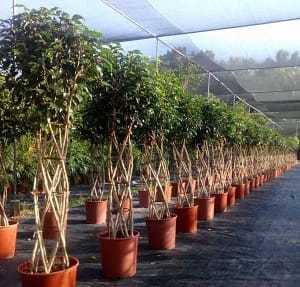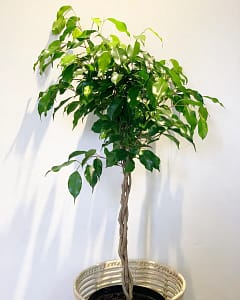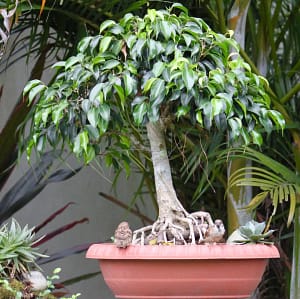About Ficus benjamina
The Ficus benjamina is an elegant and quick-growing tropical plant from Asia which has been popularised in homes and offices around the world due it its deep green foliage and ease of growth. Otherwise known as the weeping fig and commonly sold just as Ficus, the plant grows a large number of relatively small, deep green leaves and is often trained to grow a decorative trunk.
The weeping fig grows quickly during the growing season and can easily put out a few feet of growth each year if conditions are suitable. Providing the right conditions is quite easy, as the benjamina is very forgiving and will very rarely show signs of stress unless there is a sudden change in schedule.
While the benjamina can reach 15 metres in the wild forests of Southeast Asia, this species is unlikely to eclipse 1.5 metres indoors but can be easily pruned to almost any size and shape you like.
If you’re looking for your first plant, weeping figs are an excellent option that is long-lived with minimal maintenance and is very rewarding. If this is the plant for you, read our buyer’s guide below to get your plant delivered direct to you.

Ficus benjamina in the House & Office
An excellent option for homes and offices, the benjamina has an elegant form that brings a touch of class to any bright and open space.
The small and dark green glossy leaves grow in abundance, increasing their surface area and making this one of the best plants for producing large amounts of clean oxygen and filtering out harmful gases, although the small leaves make it a little tricky to clean dust so we would recommend to pair it with several larger leaved plants.
Studies from NASA show that the species is effective in reducing levels of toxic particles in the air, including formaldehyde, xylene and toluene. For removing formaldehyde particles, this plant scored eighth place, making it one of the best plants for purifying air.
One slight inconvenience of this plant is that it is very prone to drop leaves when there is a sudden change in environment, such as a change in temperature or light. This often happens at the start of winter as temperatures drop and daylight hours get shorter. While it is not too significant, you do need to clean up dropped leaves.
Ficus benjamina Size
As this tree can grow to a significant size in the wild, it can still become a very large house plant when grown indoors. While it can reach up to 150cm indoors, it often doesn’t reach this size and can be controlled by providing it with less fertiliser and by reducing light, or by pruning it outside of the main growing season.
Height: up to 150cm / 59in / 4.9ft
Spread: up to 75cm / 29in / 2.45ft
Ficus benjamina Care
Light: This plant will thrive in bright indirect light but dislikes strong, direct light from south-facing windows, although, it will survive in lower light if it is slowly introduced to a new environment. Keep your plant within a few feet of most bright windows, but at least five feet from a south-facing window to give it good and bright indirect sunlight that isn’t too strong.
Soil: You should be careful to not allow your plant to sit in water-logged soil as this can cause root rot. To minimise any risk, add 30-40% rough material to the potting mix, such as grit, perlite, clay pebbles or similar to increase drainage. Make sure that the pot has a drainage hole and that the potting soil doesn’t remain waterlogged for any period of time.
Watering: Water your Ficus benjamina when the top couple of inches of soil feels dry, about once every one to two weeks. Do not water when the soil feels damp or the soil sticks to your finger, as this may drown the plant and cause the roots to rot.
Humidity: The Ficus benjamina loves high humidity due to its natural tropical climate, but can still thrive in much lower humidity levels like you will find in the average home or office. If you can, provide your plant with humidity levels of at least 50%, but preferably over 60%.
Humidity of as little as 40% will still be suitable for your plant if you gradually adjust it, but try to provide a consistent level of humidity where possible. You can increase the humidity by grouping your plant together with others, turning on a humidifier or by sitting the pot on top of a tray of pebbles and water. Keep your plant in a well-lit bathroom or kitchen where the humidity is highest in the home.
Feeding: Feed your weeping fig tree every two weeks during summer with standard houseplant fertiliser, and just once per month during spring and autumn. Don’t feed during winter as the plant will reduce its growth rate and salts from the feed will build up in the soil, potentially damaging the plant.
Temperature: Your tropical plant will thrive in most indoor conditions, so temperatures of 18-24°C / 64-75°F will be ideal. The benjamina will be happy at temperatures above and below those levels, if not extreme, but do not allow the plant to reach near freezing temperatures.
Ailments: Ficus plants can be prone to leaf drop, which can happen after transplanting, suddenly changing its environment, or if exposed to strong, direct sun for too long.
Further care: Read our full care guide to help your plant thrive.
Where To Buy Ficus benjamina Online
- Ebay (UK) / (USA)
- Etsy
- Bloombox Club (UK) / (USA)
- Local Facebook Groups
The Ficus benjamina is not too difficult to find either in garden centres, supermarkets, plant shops or online, but buying house plants online is the easiest way to ensure you get the plant that you want without having to make multiple trips.
The easiest place to find these available will be Ebay and Etsy, where we would recommend that you buy from a well-rated, positively-reviewed retailer online which can show a respectable return policy. But, almost all online plant stores should have this species available.
If you do buy online, you should inspect your plant after receiving the delivery and be sure to not introduce an infected or infested plant to the rest of your plant collection, to prevent any possible spread.
If you are unhappy with the plant you receive in any way, contact the retailer and begin the return and refund process, and never settle for a houseplant that is damaged or otherwise unhealthy.
FAQs
Is Ficus benjamina an indoor plant?
While no plant is naturally adapted to being indoors, the benjamina is widely known for being particularly easy to grow indoors in almost any environment. It is particularly happy with conditions that would make many other indoor plants unhappy, and typically only shows signs of stress if there is a sudden change in environment. Overall, the Ficus benjamina is an excellent indoor plant.
Is Ficus benjamina toxic?
Like all Ficus trees, the sap is toxic. Touching the sap of the plant or consuming any part of it can cause irritation to the eyes, nose, mouth and skin, so it is important to keep the plant away from children and pets who may try to eat it. If the plant is damaged, be careful not to touch the sap and strongly consider wearing gloves.


